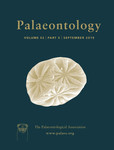Reg. Charity No. 1168330

Many metrics are used to predict and manage wildfires today but it is difficult to directly apply these to past wildfires histories. Developing an approach that enables estimation of these fire metrics in the past would provide significant power in our ability to compare past fire risk with that of the modern day. We use the Climate Leaf Analysis Multivariate Program (CLAMP) to estimate warm month mean temperature and annual mean relative humidity for a modern day leaf dataset and establish a novel methodology by which we can generate ‘pseudo‐daily’ meteorological parameters to calculate the probability of ignition (p(I)), an aspect of the North American Fire Danger Rating System. We test this methodology on Tortonian aged fossil leaves (11.62–7.25 Ma) from five sites across California, which reveal that the Tortonian was cooler and considerably more humid and that p(I) was lower during this time than in the region today.